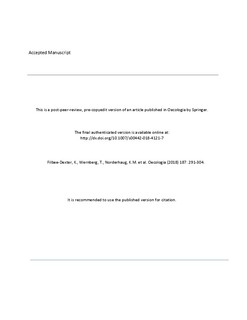| dc.contributor.author | Filbee-Dexter, Karen | |
| dc.contributor.author | Wernberg, Thomas | |
| dc.contributor.author | Norderhaug, Kjell Magnus | |
| dc.contributor.author | Ramirez-Llodra, Eva | |
| dc.contributor.author | Pedersen, Morten Foldager | |
| dc.date.accessioned | 2020-01-24T11:28:19Z | |
| dc.date.available | 2020-01-24T11:28:19Z | |
| dc.date.created | 2018-07-04T10:50:47Z | |
| dc.date.issued | 2018 | |
| dc.identifier.citation | Oecologia. 2018, 187 (1), 291-304. | nb_NO |
| dc.identifier.issn | 0029-8549 | |
| dc.identifier.uri | http://hdl.handle.net/11250/2637810 | |
| dc.description.abstract | Resource subsidies in the form of allochthonous primary production drive secondary production in many ecosystems, often sustaining diversity and overall productivity. Despite their importance in structuring marine communities, there is little understanding of how subsidies move through juxtaposed habitats and into recipient communities. We investigated the transport of detritus from kelp forests to a deep Arctic fjord (northern Norway). We quantified the seasonal abundance and size structure of kelp detritus in shallow subtidal (0‒12 m), deep subtidal (12‒85 m), and deep fjord (400‒450 m) habitats using a combination of camera surveys, dive observations, and detritus collections over 1 year. Detritus formed dense accumulations in habitats adjacent to kelp forests, and the timing of depositions coincided with the discrete loss of whole kelp blades during spring. We tracked these blades through the deep subtidal and into the deep fjord, and showed they act as a short-term resource pulse transported over several weeks. In deep subtidal regions, detritus consisted mostly of fragments and its depth distribution was similar across seasons (50% of total observations). Tagged pieces of detritus moved slowly out of kelp forests (displaced 4‒50 m (mean 11.8 m ± 8.5 SD) in 11‒17 days, based on minimum estimates from recovered pieces), and most (75%) variability in the rate of export was related to wave exposure and substrate. Tight resource coupling between kelp forests and deep fjords indicate that changes in kelp abundance would propagate through to deep fjord ecosystems, with likely consequences for the ecosystem functioning and services they provide. | nb_NO |
| dc.language.iso | eng | nb_NO |
| dc.title | Movement of pulsed resource subsidies from kelp forests to deep fjords | nb_NO |
| dc.type | Journal article | nb_NO |
| dc.type | Peer reviewed | nb_NO |
| dc.description.version | submittedVersion | nb_NO |
| dc.source.pagenumber | 291-304 | nb_NO |
| dc.source.volume | 187 | nb_NO |
| dc.source.journal | Oecologia | nb_NO |
| dc.source.issue | 1 | nb_NO |
| dc.identifier.doi | 10.1007/s00442-018-4121-7 | |
| dc.identifier.cristin | 1595571 | |
| dc.relation.project | Norges forskningsråd: 255085 | nb_NO |
| cristin.unitcode | 7431,28,0,0 | |
| cristin.unitname | Bunnsamfunn og kystinteraksjon | |
| cristin.ispublished | true | |
| cristin.fulltext | postprint | |
| cristin.qualitycode | 1 | |
